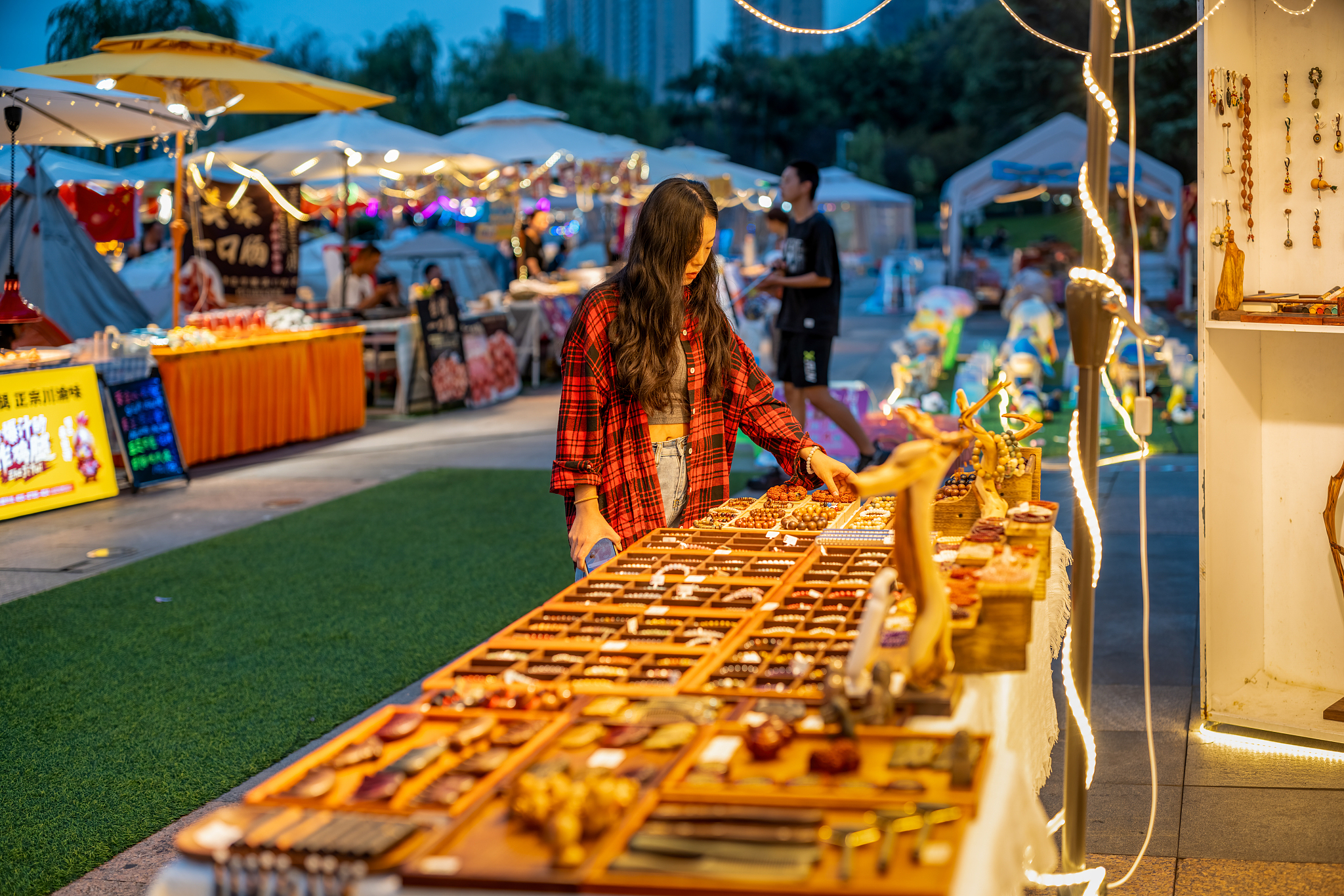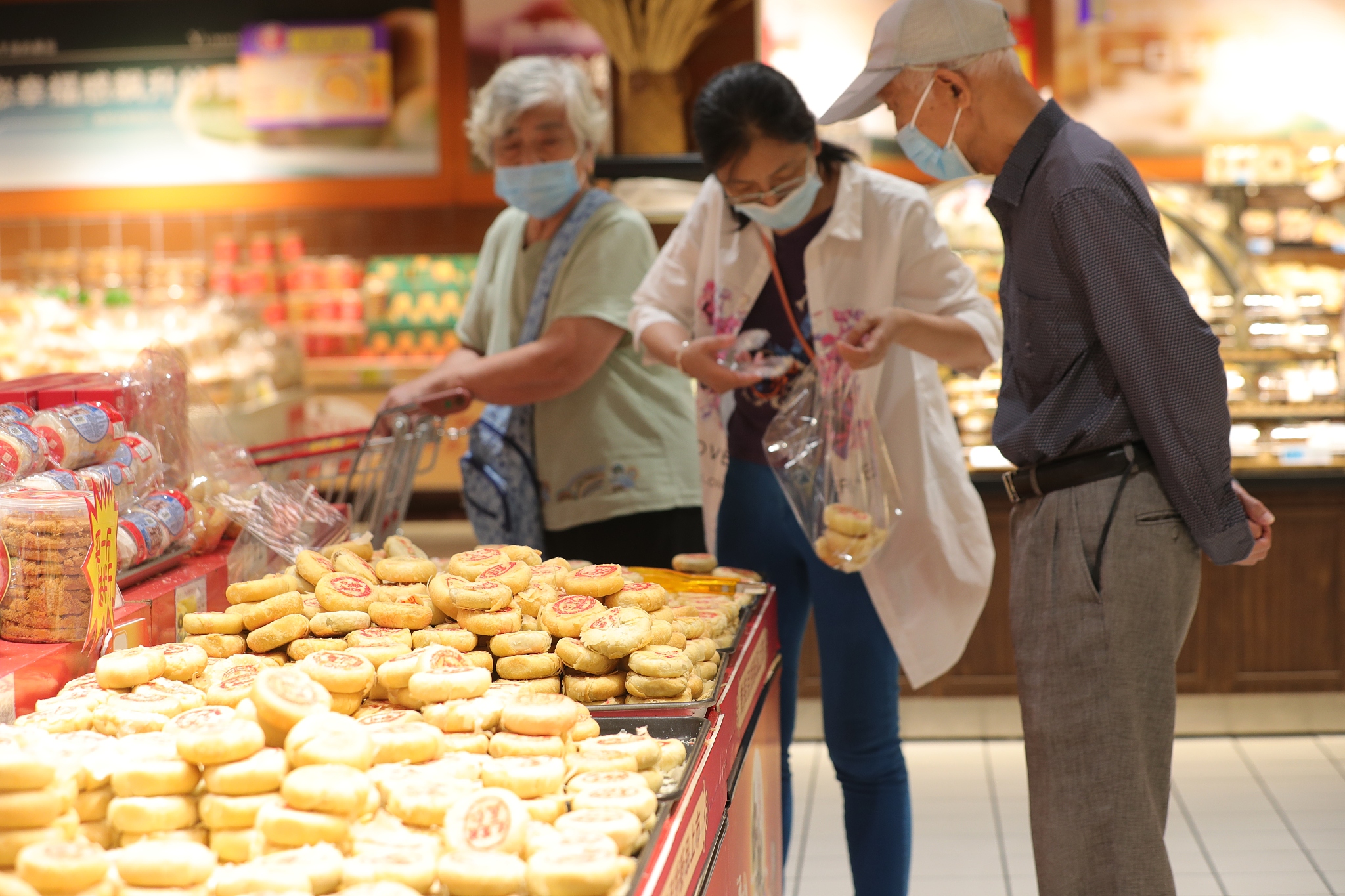
A resident picking up mooncake at a night market in Nanbin Road in Chongqing Municipality, southwest China, September 28, 2023. /CFP
A resident picking up mooncake at a night market in Nanbin Road in Chongqing Municipality, southwest China, September 28, 2023. /CFP
China's Mid-Autumn Festival, a time when families and communities come together to enjoy a bountiful feast and express gratitude to Mother Earth for the summer harvest, falls on the 15th day of the eighth lunar month. This year, it is celebrated on September 29.
During the festival, which coincides with the fullest and brightest phase of the moon, people enjoy mooncakes, round pastries that symbolize togetherness and are often adorned with the symbols of "longevity" or "harmony" on their tops.
In ancient times, mooncakes served as offerings to the moon. Over the centuries, these distinctive cakes have evolved into the hallmark cuisine of the Mid-Autumn Festival. In contemporary times, various new types of mooncakes have emerged with the passage of time.
Diverse flavors of Chinese mooncakes across regions
While Chinese mooncakes share common symbolic significance, their flavors vary from region to region, ranging from sweet, dense custard fillings containing salted egg yolks to savory fillings featuring ham or roast pork.
The most common one is the traditional Cantonese-style mooncakes, whose fillings consist of lotus paste, a sweet blend made from lotus seeds, and salted duck egg yolks. Such a combination is sweet, fragrant and slightly salty. Additionally, mooncakes also have fillings like red bean paste, mung bean paste, sesame paste or a mix of five seeds.

The most common type of mooncake is the Cantonese-style, known for its lotus-like shape and ornate embossed pattern on top. /CFP
The most common type of mooncake is the Cantonese-style, known for its lotus-like shape and ornate embossed pattern on top. /CFP
Another popular type of mooncake is the snow-skin mooncake, which differs from the traditional baked version. They use glutinous rice flour for their outer layer and are often colorful, filled with classic lotus seed paste, as well as chilled or frozen options like ice cream or custard.
Suzhou mooncakes, distinct from their Cantonese counterparts, are smaller and encased in a flaky crust made from lard or butter, and are recognizable by the sprinkle of black sesame on top. Traditionally, they were cooked in deep cast-iron pans, but today, they are more commonly baked for mass production.
Originating from southwest China's Yunnan Province, Yunnan-style mooncakes stand out for their use of various flours in the dough. The climate in Yunnan is ideal for curing meat, and Xuanwei ham takes the spotlight in Yunnan's sweet-savory mooncakes. These mooncakes feature a crisp exterior and a soft filling comprised of diced Xuanwei ham, lard, honey and sugar.
Whether it's the Cantonese-style mooncakes in the southern regions or the bean paste mooncakes in the northern areas, both symbolize the importance of reunion and traditional values. They have become an integral part of the Chinese Mid-Autumn Festival's cultural tapestry.

A mooncake mold featuring Chinese characters "tuan yuan" (which means "reunion"). /Xinhua
A mooncake mold featuring Chinese characters "tuan yuan" (which means "reunion"). /Xinhua
New flavored mooncake market is booming
While traditional mooncakes filled with sweet bean paste, lotus seeds, roasted pork, nuts and egg yolk remain the most popular choice among consumers, there is also a growing interest in new mooncake flavors, according to a recent report by the research firm iiMedia Research.
In 2022, the retail sales value of traditional-flavored mooncakes in China was estimated to reach 9.5 billion yuan ($1.3 billion), and new-flavor mooncakes like ice cream-flavored ones are expected to generate sales worth approximately 5.9 billion yuan this year, as estimated by Statista, a global data platform.
This trend is creating new business opportunities for mooncake manufacturers, leading to a growing diversification of mooncake sales channels.
Currently, sales channels for the mooncakes primarily fall into two categories: traditional and e-commerce. Notably, live-streamed e-commerce is experiencing a rapid growth.
Traditional channels include supermarkets, shopping malls, specialty stores and gift shops. These channels have relatively stable customer bases and remain pivotal for mooncake sales.
Emerging sales channels in recent years include e-commerce platforms and social media, which offer a wide array of mooncake choices and regularly launch various promotions and incentives for consumers to purchase.

Customers pick up mooncakes at a supermarket in Yangzhou, east China's Jiangsu Province, September 27, 2023. /CFP
Customers pick up mooncakes at a supermarket in Yangzhou, east China's Jiangsu Province, September 27, 2023. /CFP
Besides, more than 60 percent of consumers expressed the need to give gifts during the festival season, and 86.2 percent of consumers said they would like to buy mooncakes packaged in gift boxes, the report said.
Due to consumer preferences for diverse flavors, increased demand for gifting and the expansion of sales channels, including live streaming platforms, the mooncake gift box market is projected to reach 20.87 billion yuan by 2023 and 24.7 billion yuan by 2025, as reported by iiMedia Research.
In recent years, the Chinese market has witnessed a surge in imported mooncakes, driven by growing domestic demand for more diversified flavors as well as the rising popularity of mooncake culture.
As of September 26, Huangpu Customs in south China's Guangdong Province recorded the import of approximately more than 295 tonnes of mooncakes and other festive foods.
Mooncakes such as the durian snow-skin varieties from Malaysia and various others from different countries and regions have gained increasing popularity from consumers.